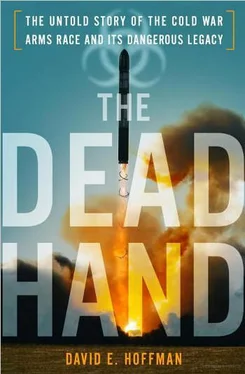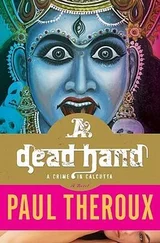———
In his new assignment, Domaradsky was to work in the shadows. All documents concerning Ferment were transported with armed escort in special vehicles. Meetings of the council were held in a specially soundproofed hall, which was checked for bugs by the security services before every meeting. Domaradsky’s subscriptions to scientific literature had to be screened in advance by the security service. He was prohibited to travel outside the Soviet bloc, and often not even there. “I knew too much,” he acknowledged. The travel restrictions, often imposed on those with access to top-secret materials, nonetheless caused him embarrassment. “I had to think up some reason for turning down pressing and very tempting invitations from my foreign colleagues.” He would say he had broken his leg, or come down with an illness, or he had “family problems.” Once, he was on the verge of leaving for an international conference on microbiology in Munich. At the very last minute, the KGB man accompanying the delegation stopped Domaradsky in the street, told him he could not go and demanded his ticket and travel money back.
Domaradsky and his researchers held ten “inventor’s certificates,” for introducing genetic material into plague, but these papers were classified. Keeping such papers secret was common procedure. Domaradsky was given only a number and date of registration. To see his own certificates he had to enter a special security room and could not take any documents out.
Domaradsky was deeply conflicted. He desired to explore science, yet was aware he was contributing to instruments of death. The pathogens he developed would eventually be turned into weapons, although he did not deal with the actual bombs, just the germs. “I found the science of Problem Ferment intriguing indeed,” he said. “The attraction of that science seemed more important to me than what was to be done with its results.” He added, “Compromising with my conscience seemed, at the time, like a small price to pay.” Domaradsky said his family’s long struggle with persecution had taught him to be ready to bend. “To survive, I had to hide my true attitude toward the Soviet regime from childhood; I learned quite early to adapt myself to this regime.”
Moreover, Domaradsky felt a “vaulting pride” at being in the heart of the Soviet effort. He had a secure Kremlin phone, car and good salary. “We saw ourselves engaged in patriotic work,” he said, “advancing the study of molecular biology, immunology, and genetics in the Soviet Union, where these fields had been allowed to languish.” He knew of the treaty prohibiting biological weapons, but assumed Americans were also cheating.
At the core of the entire bioweapons effort, Domaradsky was in position to see the paperwork, talk to the military and visit the laboratories. As Biopreparat took shape, Domaradsky drafted a plan, approved in 1975, to expand the drive for genetically engineered germ weapons in five major directions, including resistance to antibiotics. This was a key turning point. Programs got underway to transfer the genes from various deadly agents into the cells of bacteria, or into the DNA of viruses, to boost the pathogenetic factors. Domaradsky wanted to inject the genetic material directly into plague. These programs were called “Bonfire” and “Factor.” While Domaradsky worked as deputy director of the council in Moscow, the council also set up a parallel program to use genetically altered viruses and germ weapons to devastate crops and livestock, Project “Ecology.”
As a young man, Domaradsky had admired the heroic workers of the anti-plague institutes, who protected the public from scourge. Now, the same institutes were quietly dragged into the search for agents of killing. According to Domaradsky, the “Problem No. 5” for civil defense became a cover story for weapons work. The institutes were asked to gather dangerous pathogens they found on the steppe, and to study what made them virulent, so they could be fed into the Biopreparat flasks.
The Biological Weapons Convention entered into force on March 26, 1975. That June, Alexei A. Roshchin, the Soviet ambassador to the disarmament committee in Geneva, declared: “At the present time, the Soviet Union does not have in its possession any bacteriological (biological) agents or toxins, weapons, equipment or means of delivery specified in Article 1 of the Convention.” 13
Whether Roshchin was aware of the reality is unknown, but Domaradsky certainly knew the truth. “I knew that I was part of a system that was out of control, but I could not think of an alternative way to live my life,” Domaradsky reflected later. “Like my colleagues, I faced a terrible choice: remain with a corrupt and non-functioning system, doing work of (at best) a certain moral ambiguity, or sacrifice my entire scientific career.”
———
Soon after the biological weapons treaty was ratified, U.S. intelligence satellites picked up signs of unusual new factories being built in the Soviet Union. William Beecher, the military correspondent of the Boston Globe , reported that satellites detected six potential biological warfare facilities. The plants “feature extremely high smokestacks and refrigerated storage bunkers associated with germ warfare production,” Beecher wrote. 14
Then in April 1979 came the Sverdlovsk anthrax epidemic. Fragmentary reports began to reach the West. The intelligence community had long suspected a secret Soviet biological weapons program existed. Now perhaps there was evidence.
The first reports began filtering into the U.S. Central Intelligence Agency through Soviet émigrés. A top-secret CIA intelligence report on October 15, 1979, cited an unnamed Soviet émigré as saying that three close friends had told him in May “of an accident at a biological warfare (BW) institute in Sverdlovsk which resulted in 40 to 60 deaths. Other sources have also heard rumors of such an accident.” The report was vague, but noted there was “a suspect BW installation in Sverdlovsk” and that “two reports of the accident suggested a disease that also affects cattle, and one source identified the bacterial agent anthrax as a possible cause.” 15
In December, Soviet forces invaded Afghanistan. The SALT II treaty was endangered. If the Soviets were found to have violated the five-year-old biological weapons treaty, it would be yet another serious setback to ratification of the nuclear arms agreement.
Unexpectedly, fresh intelligence arrived in Washington about Sverdlovsk. A secret CIA report on January 28, 1980, said: “Recent intelligence strengthens allegations that an accident at a BW installation caused civilian casualties in southern Sverdlovsk during April 1979.” This report added the claim of a possible explosion at the plant that caused the release. The report said that “pathogenic bacteria allegedly escaped into the air and spread over industrial and residential areas of southern Sverdlovsk.” The report also took note that, “An announcement about an anthrax epidemic in a public health context appears to have been designed to prevent a possible panic among Sverdlovsk’s million-plus population. The magnitude of the epidemic and the causative organism remain conjecture.”
In January and February 1980, a practicing surgeon from a Sverdlovsk hospital gave U.S. intelligence agencies a new and more detailed account, which the Defense Intelligence Agency described in a top-secret report March 3. Although some details were vague, the surgeon was correct about many specifics. He said the accident occurred inside a military installation where “dispersible biological weapons” were produced. He said that in April 1979 there had been a “loud explosion which was attributed to a jet aircraft”—this later turned out to be an error—and he noted that within four days, victims had been arriving at Hospital No. 20.
Читать дальше












